Verticordia verticordina is a flowering plant in the myrtle family, Myrtaceae and is endemic to a small area near the coast of the south-west of Western Australia. It is a small, low-growing shrub with crowded leaves and in spring, scattered pale greenish-cream and golden brown flowers. Its unusual flowers and fleshy leaves give the plant a superficial resemblance to a Darwinia.

Adenanthos detmoldii, commonly known as Scott River jugflower or yellow jugflower, is a species of shrub in the family Proteaceae. It is endemic to the south-west of Western Australia.
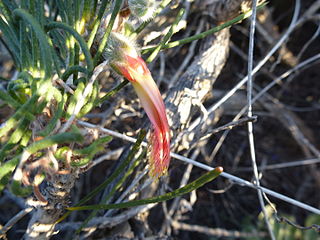
Calothamnus chrysanthereus , commonly known as claw flower is a plant in the myrtle family, Myrtaceae and is endemic to the south-west of Western Australia. It is an erect shrub with needle-shaped leaves crowded on the ends of the branches and bright red flowers in spring.
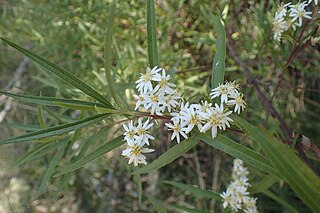
Olearia viscidula, commonly known as the viscid daisy bush or wallaby weed, is a species of flowering plant in the family Asteraceae and is endemic to eastern New South Wales. It is a shrub with scattered narrow elliptic or egg-shaped leaves that are paler on the lower surface, and panicles of white flowers arranged in leaf axils.

Calothamnus longissimus is a plant in the myrtle family, Myrtaceae and is endemic to the south-west of Western Australia. It is a small, spreading shrub with unusually long, fine leaves and which produces clusters of red flowers in spring.
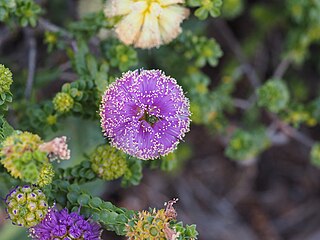
Phymatocarpus porphyrocephalus is a plant in the myrtle family, Myrtaceae and is endemic to the south-west of Western Australia. It resembles many small species of Melaleuca, mainly differing in the way its anthers are attached at the top of the stamens. In Phymatocarpus they are attached at their base and open at the other end through two slits. It is a shrub with many small heads of pink to purple flowers fading to white, often covering the plant for several weeks in spring.

Persoonia acicularis is a species of flowering plant in the family Proteaceae and is endemic to the west coast of Western Australia. It is a shrub with linear, sharply-pointed leaves and yellow flowers in groups of up to eighty.

Hakea rhombales, commonly known as walukara, is a shrub in the family Proteacea. It has red, pink or purple flowers and is endemic to Western Australia and the Northern Territory.

Pityrodia hemigenioides is a flowering plant in the mint family Lamiaceae and is endemic to the south-west of Western Australia. It is a spreading shrub with densely hairy branches and leaves, and pale white flowers near the ends of the branches.
Calytrix decandra, commonly known as the pink starflower, is a species of plant in the myrtle family Myrtaceae that is endemic to Western Australia.
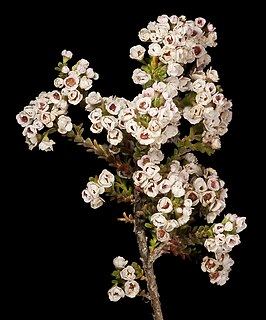
Scholtzia parviflora is a shrub species in the family Myrtaceae that is endemic to Western Australia.
Scholtzia uberiflora is a shrub species in the family Myrtaceae that is endemic to Western Australia.
Thryptomene elliottii is a species of flowering plant in the family Myrtaceae and is endemic to southern central Australia. It is a shrub with decussate, egg-shaped to club-shaped leaves and pink or white flowers with five petals and five stamens.

Parsonsia diaphanophleba is a woody vine of the family Apocynaceae. It is found in Western Australia and is listed as a priority 4 species.

Liparis habenarina, commonly known as the common sphinx orchid or common hobgoblin orchid, is a plant in the orchid family and is endemic to Australia. It is a deciduous, terrestrial orchid with two or three egg-shaped leaves and between eight and twenty-two brownish to purplish flowers with their lateral sepals joined at the base. It grows in the understorey of near-coastal forests.
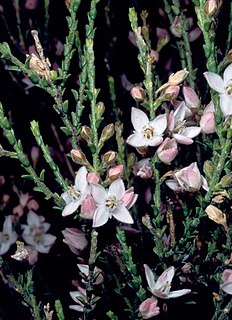
Boronia baeckeacea is a plant in the citrus family, Rutaceae and is endemic to eastern Australia. It is a slender or straggling shrub with simple or trifoliate leaves and pink and white four-petalled flowers. It is endemic to the south-west of Western Australia.
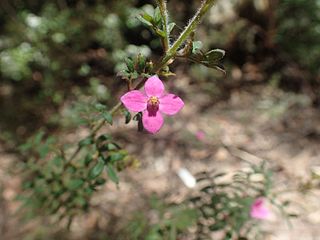
Boronia gracilipes, commonly known as karri boronia, is a plant in the citrus family, Rutaceae and is endemic to the south-west of Western Australia. It is an erect, spindly shrub with compound leaves and pink, four-petalled flowers.

Olearia magniflora, commonly known as the splendid daisy-bush, is a small shrub with clusters of deep mauve to purple flowers.

Leucopogon plumuliflorus is a shrub in the family Ericaceae. It is endemic to Western Australia.

Phlebocarya filifolia is a plant in the Haemodoraceae family, native to Western Australia.
















